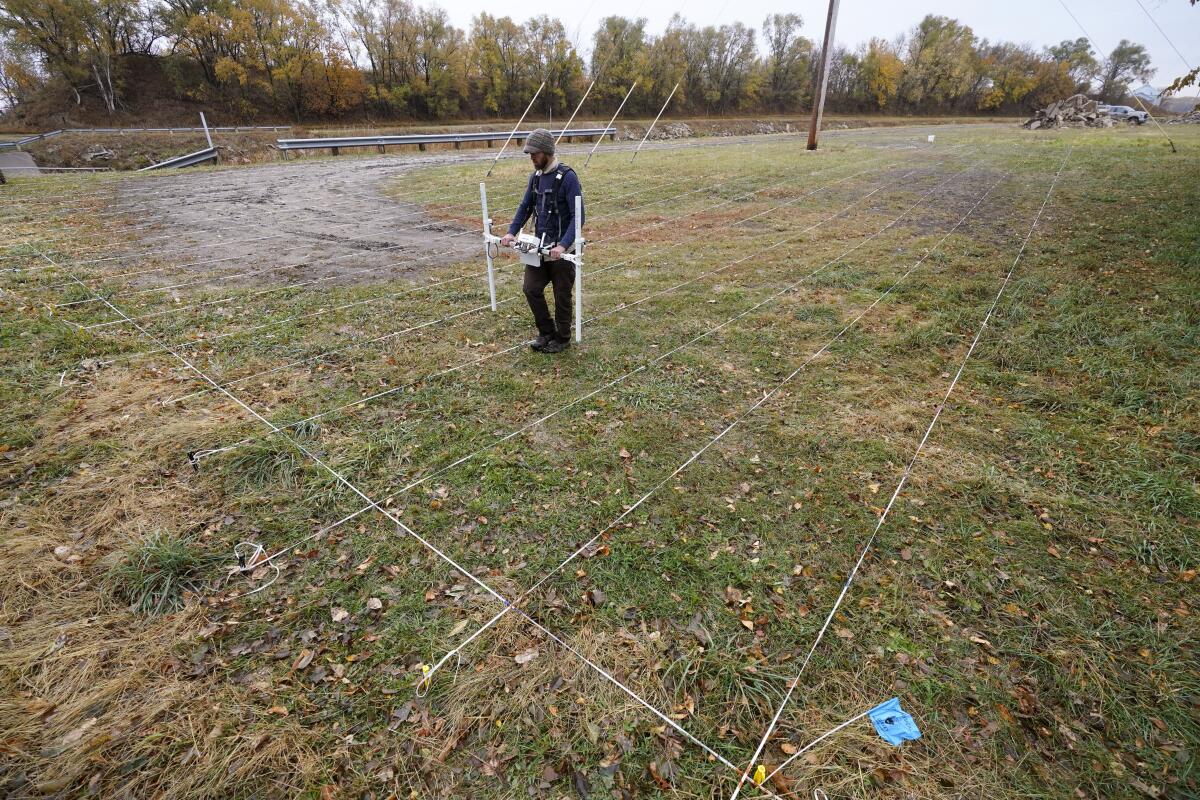In search of a lost cemetery, dig begins at former Native American school in Nebraska

- Share via
GENOA, Neb. — Bodies of dozens of children who died at a Native American boarding school have been lost for decades, a mystery that archeologists aim to unravel as they dig in a central Nebraska field that a century ago was part of the sprawling campus.
Crews toting shovels, trowels and even smaller tools are searching at the site experts suspect is the Genoa Indian Industrial School cemetery. Genoa was part of a national system of more than 400 Native American boarding schools that attempted to integrate Indigenous people into white culture by separating children from their families and cutting them off from their heritage.
The school, about 90 miles west of Omaha, opened in 1884 and at its height was home to nearly 600 students from more than 40 tribes across the country. It closed in 1931 and most buildings were long ago demolished.
For decades, residents of the tiny community of Genoa, with help from Native Americans, researchers and state officials, have sought the location of a forgotten cemetery where the bodies of up to 80 students are believed to be buried.
The report released by the Interior Department expands the number of schools that were known to have operated for 150 years, starting in the early 19th century.
Judi gaiashkibos, the executive director of the Nebraska Commission on Indian Affairs, whose mother attended the school in the late 1920s, has been involved in the cemetery effort for years and planned to travel to Genoa on Monday. She said it’s difficult to spend time in the community where many Native Americans suffered, but the vital search can help with healing and bringing the children’s voices to the surface.
“It’s an honor to go on behalf of my ancestors and those who lost their lives there and I feel entrusted with a huge responsibility,” gaiashkibos said.
Newspaper clippings, records and a student’s letter indicate at least 86 students died at the school, usually due to diseases such as tuberculosis and typhoid, but at least one death was blamed on an accidental shooting.
Researchers have identified 49 of the children but have not been able to find names of 37 students. The bodies of some of the children were returned to their families but others are believed to have been buried on the school grounds at a location long ago forgotten.
As part of an effort to find the cemetery, last summer dogs trained to detect the odor of decaying remains searched the area and signaled they had found a burial site in a narrow piece of land bordered by a farm field, railroad tracks and a canal.
The U.S. government hasn’t been open to investigating its role in stripping Native Americans of their cultures and identities in boarding schools.
A team using ground-penetrating radar last November also showed an area that was consistent with graves, but there will be no guarantees until researchers can dig into the ground, said Dave Williams, Nebraska’s state archeologist.
The process is expected to take several days.
“We’re going to take the soil down and first see if what’s showing up in the ground-penetrating radar are in fact grave-like features,” Williams said. “And once we get that figured out, taking the feature down and determining if there are any human remains still contained within that area.”
If the dig reveals human remains, the State Archeology Office will continue to work with the Nebraska Commission on Indian Affairs in deciding what’s next. They could rebury the remains in the field and create a memorial or exhume and return the bodies to tribes, Williams said.
DNA could indicate the region of the country each child was from but narrowing that to individual tribes would be challenging, Williams said.
The federal government is taking a closer examination of the boarding school system. The U.S. Interior Department, led by Secretary Deb Haaland, a member of Laguna Pueblo in New Mexico and the first Native American Cabinet secretary, released an initial report in 2022 and is working on a second report with additional details.
Neibergall reported from Genoa and McFetridge from Des Moines, Iowa.
More to Read
Sign up for Essential California
The most important California stories and recommendations in your inbox every morning.
You may occasionally receive promotional content from the Los Angeles Times.















